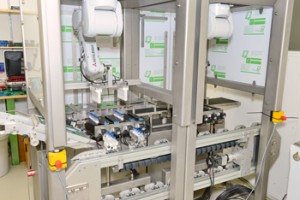Driven track for robot cell’s product transportation
 When Mike Weber, general manager of Robotronic, was looking for flexible product transportation through a new design of robot cell, he turned to the HepcoMotion. Now HepcoMotion’s DTS2 dynamic track system is playing a key role on the MRT (modular robot technology) robot cell, which provides a product feeding system for the pharmaceutical packaging industry.
When Mike Weber, general manager of Robotronic, was looking for flexible product transportation through a new design of robot cell, he turned to the HepcoMotion. Now HepcoMotion’s DTS2 dynamic track system is playing a key role on the MRT (modular robot technology) robot cell, which provides a product feeding system for the pharmaceutical packaging industry.
Early in the development phase of the MRT robot cell, Weber was looking for a very flexible drive system. One of his business partners made him aware of HepcoMotion, a supplier of linear motion systems. Weber analysed the products – which can not only be used separately as individual units but also combined with different technologies to build linear, rotary and continuous systems – and was impressed by the cleverness of the systems, which can be customised individually for most diverse requirements.
The combination of Robotronic’s modular design and HepcoMotion’s DTS2 linear system offers an individual solution, ready for serial production, and proof of concept is already taking place at a well known international customer in the pharmaceutical industry. Small glass vials in packs of five are moved onto a transport system by the new robot cell, where they are packed into blisters every second and afterwards put into a cartoning machine.
This is carried out by two parallel working robots, each of which equipped with a double gripper to pick up two times five vials and put them into blisters. The trays containing the ten vials are transported by an accurate screw drive; the carriages are directed and driven by a belt between V-slides. A Mitsubishi servo motor controls the position of the blisters.
Fast and precise handling of delicate products
Weber explains that he was looking for a system that works very precisely. The vials are made of fragile glass and can break easily, but at the same time the handling was supposed to be working both rapidly and precisely together with the robots and the feeding system. This is necessary to guarantee high efficiency and avoid problems such as machine breakdowns.
According to Weber, HepcoMotion’s system meets these challenges. Its design works with high speed and still is mechanically robust and very accurate.
Stefan Kaufmann, HepcoMotion’s salesman for Switzerland, explains that the DTS2 system which was used here uses a screw drive that positions the carriage exactly where it is needed. In this special application, six carriages are placed with a positional accuracy of ±0.2mm. An extra long drive screw was built for this custom-made design so six carriages can be driven by one screw. The carriages themselves (21 all in all) are fixed onto slides. On the outside these carriages are connected with a belt, just like a railway.
In Weber’s opinion, another reason why the modular design and the DTS2 system match so perfectly is the possibility to combine it with Mitsubishi motors. Standard motors are often used together with ready designed systems – with HepcoMotion’s solution, they can work with their own individual motors.
When using Mitsubishi motors, up to eight extra servo axes can be driven directly by the robot system. The additional axis is designed for the robot and operated by the robot controller. This is an interpolating task which must be carried out with high positional accuracy, another important aspect.
This system offers a very flexible but at the same time robust and easy to handle technology which mechanical construction guarantees high positional accuracy during a long system life.
Weber plans to use HepcoMotion products as a standard component for the modular robot cells, enabling higher dynamics with the ability to drive the screw at higher speed without risk for the belt to skip.
Visit the HepcoMotion website for more information on the DTS2 dynamic track system
See all stories for HepcoMotion















